

Technology_001. New Study Highlights 5 Benefits of Emerging Classroom Technology. New Study Highlights 5 Benefits of Emerging Classroom Technology According to a new study, the majority of educators say technology positively impacts the classroom.
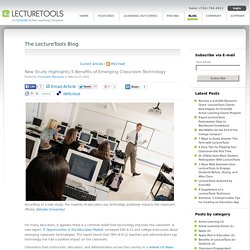
(Photo: DeSales University) For many educators, it appears there is a common belief that technology improves the classroom. A new report, IT Opportunities in the Education Market, surveyed 500 K-12 and college instructors about emerging classroom technologies. The report found that 78% of K-12 teachers and administrators say technology has had a positive impact on the classroom.
Comments from instructors, educators, and administrators across the country in a related US News article revealed a number of innovative ways that technology is being used to improve instruction. 1. For teachers like Stacey Roshan, emerging technologies have helped students perform better on important tests. 2. Social and Cultural Foundations of American Education/Technology/Pros and Cons. What are the pros and cons of technology in the classroom?
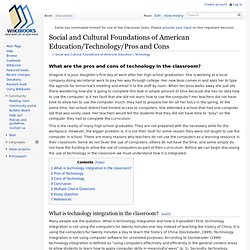
Imagine it is your daughter’s first day of work after her high school graduation. She is working at a local company doing secretarial work to pay her way through college. Her new boss comes in and asks her to type the agenda for tomorrow’s meeting and email it to the staff by noon. When her boss walks away she just sits there wondering how she is going to complete this task in ample amount of time because she has no idea how to use the computer. Is it her fault that she did not learn how to use the computer?
This is the reality of many high school graduates. Negative Effects of Using Technology in Today's Classroom. The negative impact of technology on our brains. Although technology has countless benefits in our lives, there are more and more reports that suggest there is an accompanying negative effect on our brains and on our children’s development, as I have written in the past.

A recent article in the New York Times paints a scary picture: some teens prefer the instant gratification of a YouTube video or a Facebook status update, to the enriching (albeit, delayed) gratification that one can glean from reading a book. Although children have always enjoyed distractions when it comes to work, technology has carried a whole new slew of tools with which to procrastinate with that prove to be increasingly dangerous. Growing Up Digital, Wired for Distraction By MATT RICHTEL REDWOOD CITY, Calif. — On the eve of a pivotal academic year in Vishal Singh’s life, he faces a stark choice on his bedroom desk: book or computer? He typically favors Facebook, YouTube and making digital videos. On YouTube, “you can get a whole story in six minutes,” he explains. Effects%20of%20Technology%20Integration%20Education%20on%20the%20Attitudes%20of%20Teachers%20and%20Students%20(1)
Pros of technology in the classroom. What are the Advantages /Disadvantages of Technology in the classroom. Pros and Cons of Computer Technology in the Classroom Author: Kathleen Patrice Gulley University: California State University, Sacramento Course: Educational Leadership and Policy Studies EDLP 225 :: Advanced Seminar: Ethical Decision Making Instructor: Dr.
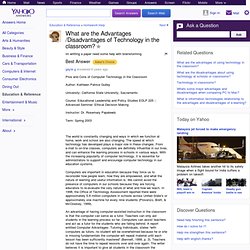
Rosemary Papalewis. Technology and Education. The internet is the real collaborative force within education, as the mere involvement of any form of technology does not guarantee substantial effects on education quality.
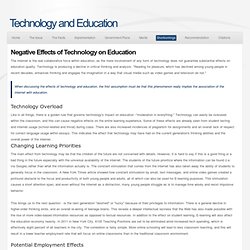
Technology is producing a decline in critical thinking and analysis. "Reading for pleasure, which has declined among young people in recent decades, enhances thinking and engages the imagination in a way that visual media such as video games and television do not. " When discussing the effects of technology and education, the first assumption must be that this phenomenon really implies the association of the internet with education. Education Blog»»The Negative Effects of Technology on Students. In current times, technology plays such a huge role in our everyday lives, and for most people in our current society, it’s something we rely on to function throughout the duration of a twenty-four hour day.

The education system today is no different, as it has adopted and embraced technology as a way for students to learn, complete research, complete homework assignments and projects, etc. It’s a known fact that technology has contributed to the world’s evolution and has eased the workload of it’s inhabitants. However, when it comes to technology in the classroom, is it doing more harm than good? An article written by S.D. Benefits Of Using Technology In The Classroom. Technology In The Classroom! The future of learning has arrived, and it’s fully interactive!

Digital technology is gradually transforming the K-12 classroom environment. Student and teacher roles are in flux, with students now taking an active part in their own learning. With the increasingly common use of new technologies like interactive whiteboards and networked learning environments, teachers are also becoming learners as they shift into new styles of information sharing. Many classrooms are also undergoing physical changes to accommodate the structural needs of a technology-dependent curriculum.
The classroom of the 21st century reaches out beyond its four walls, bringing in external resources with digital tools. The Advantages of Technology in the Classroom. Technology is often intriguing to students, leading to a higher degree of student motivation.
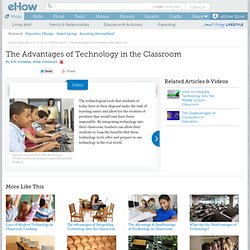
When students tire of exploring standard written texts or composing essays on paper, teachers can regain their interest by providing them with technology-rich lessons that allow them to use technology to learn and produce creative and dynamic products, such as digital movies or multi-media presentations. Because students are more interested in creating their intriguing works, they focus more attention on the completion of the task and, by connection, learn more. Effects of Technology on Classrooms and Students. A r c h i v e d I n f o r m a t i o n Change inStudent andTeacherRoles When students are using technology as a tool or a support for communicating with others, they are in an active role rather than the passive role of recipient of information transmitted by a teacher, textbook, or broadcast.
The student is actively making choices about how to generate, obtain, manipulate, or display information. Technology use allows many more students to be actively thinking about information, making choices, and executing skills than is typical in teacher-led lessons. Moreover, when technology is used as a tool to support students in performing authentic tasks, the students are in the position of defining their goals, making design decisions, and evaluating their progress. The teacher's role changes as well.
Project-based work (such as the City Building Project and the Student-Run Manufacturing Company) and cooperative learning approaches prompt this change in roles, whether technology is used or not. 10472. TECHNOLOGY IN THE CLASSROOM: TOO MUCH OF A GOOD THING? by Bonnie Thone Boylan. To preface this article, I originally set out to report on how teachers can best use technology in the classroom.
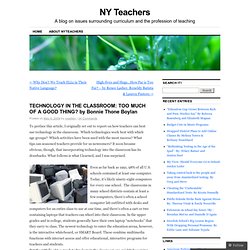
Which technologies work best with which age groups? Which activities have been used with the most success? What tips can seasoned teachers provide for us newcomers? It soon became obvious, though, that incorporating technology into the classroom has its drawbacks. What follows is what I learned, and I was surprised. Even as far back as 1991, 98% of all U.S. schools contained at least one computer. References:www.genevalogic.comwww.ResponsibilityProject.comwww.smartech.com Like this: Like Loading...
Negative Effects of Computers in Classrooms. Negative Effects of Computers in Classrooms By Jessy Norman Computers and other related technologies have become an enormous part of our daily lives.
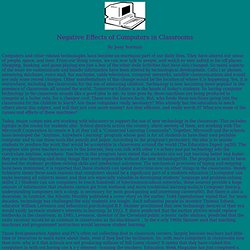
They have altered our sense of people, space, and time. From our living rooms, we can now talk to people, and watch ev ents unfold in far-off places. Shopping, banking, and game playing are just a few of the other daily activities that have also changed. Today, major compa nies are working with educators to support the use of new technology in the classroom. Those first-generation Apples and PC's often sat collecting dust in classroom corners, largely because teachers had little time or resources to learn more about them, even if they had the inclination. Today, however schools and teacher education programs a re having to assist teachers in learning the technology skills they need in order to prepare for life in the future. Although, doing so for these districts is not as easy as it sounds. So, does this all make sense? Works Cited.
The Problem with Modern Technology in the Classroom. Students: Technology in the Classroom. The integration of technology in education is no longer a "new" idea. Because technology has become such an integral part of society, it is necessary to integrate its use in education in a variety of ways. The use of computer technology has moved beyond computer assisted instruction in the form of tutorials or drill and practice. Today's technology can provide teachers and students with opportunities for teaching and learning that were impossible in the past. Computers can be used as devices for communicating with people literally a world apart.
They can be used as tools to create instructional materials or as presentation devices to provide information in ways never before possible. Teachers Report Educational Benefits of Frequent Technology Use. Research | News Teachers Report Educational Benefits of Frequent Technology Use Teachers who use technology frequently in their classrooms perceive greater benefits to student learning--particularly learning 21st century skills--than teachers who are less frequent users.
That's one of the major findings from a K-12 technology study released Monday by researchers out of the Richard W. Riley College of Education and Leadership at Minnesota's Walden University. The report, titled "Educators, Technology and 21st Century Skills: Dispelling Five Myths," was based on a survey of more than 1,000 K-12 educators and school administrators in the United States, specifically 783 teachers and 274 principals or assistant principals.